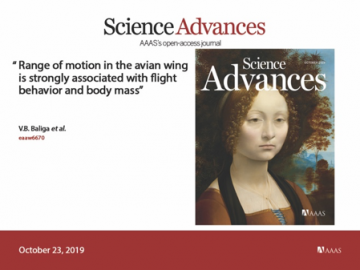Understanding the biodiversity of birds takes on a new twist in this new collaboration between UBC comparative physiologists Dr. Vikram Baliga and Dr. Doug Altshuler and Collections Curator at the BBM Ildiko Szabo. They are rethinking bird wings.
Their new research, published in Science Advances, helps explain why bird species that have similar styles of flight may not need to have similar wing shapes. The key is the range of motion within the wing. As new flight styles or changes in birds’ body masses evolve, nature reshapes the range of motion of birds’ wings more than the wing shape or size.

Ildiko Szabo, BBM avian collection curator obtaining wings for Range of Motion Analysis of 50 % of the world’s bird orders. UBC Physiologists, Dr. Vikram Baliga (center) and Dr. Doug Altshuler examine the now dried and prepared wings that will in perpetuity voucher their ground-breaking experiment. The wings will be housed at the BBM Cowan Tetrapod Collection. Photo by Derek Tan
“The key finding is that the range of motion of the wing shows stronger correspondence to a bird’s size and how it flies than its wing shape does,” explains Baliga, the lead author and Postdoctoral Research Fellow in UBC’s Zoology department.
Walking through the BBM bird displays highlights that wings come in an array of shapes and colours but it is birds’ physical abilities, and especially their ability to use their wings to dart about and soar at great heights, that really captivates our attention.
“We were inspired by watching how birds fly,” Baliga adds. “Birds don’t really flap with wings held straight and stiff. They fold, unfold, bend, and twist their wings as part of normal flapping behavior. It’s similar to how we use our arms when we swim.”
Wing motion was digitized and analyzed. This video shows the range of motion for the wing of a belted kingfisher (Note: All bird cadavers used died either of natural causes or collision injuries from vehicles or windows. No birds were harmed or killed for this study.)
Their research also provides inspiration for engineers who may seek to improve wings on aircraft. Next-generation drones and other aerial vehicles may benefit from biomimicry, borrowing the “morphing” capability that bird wings have.
“Evolution has tested a range of wing designs and wing mechanics for specific circumstances,” adds Baliga. “Looking at the restrictions that nature places on birds of different sizes and flight styles gives us insights on what does and does not work when designing new technology.”
Click here to see the article on the Science Advances site.

